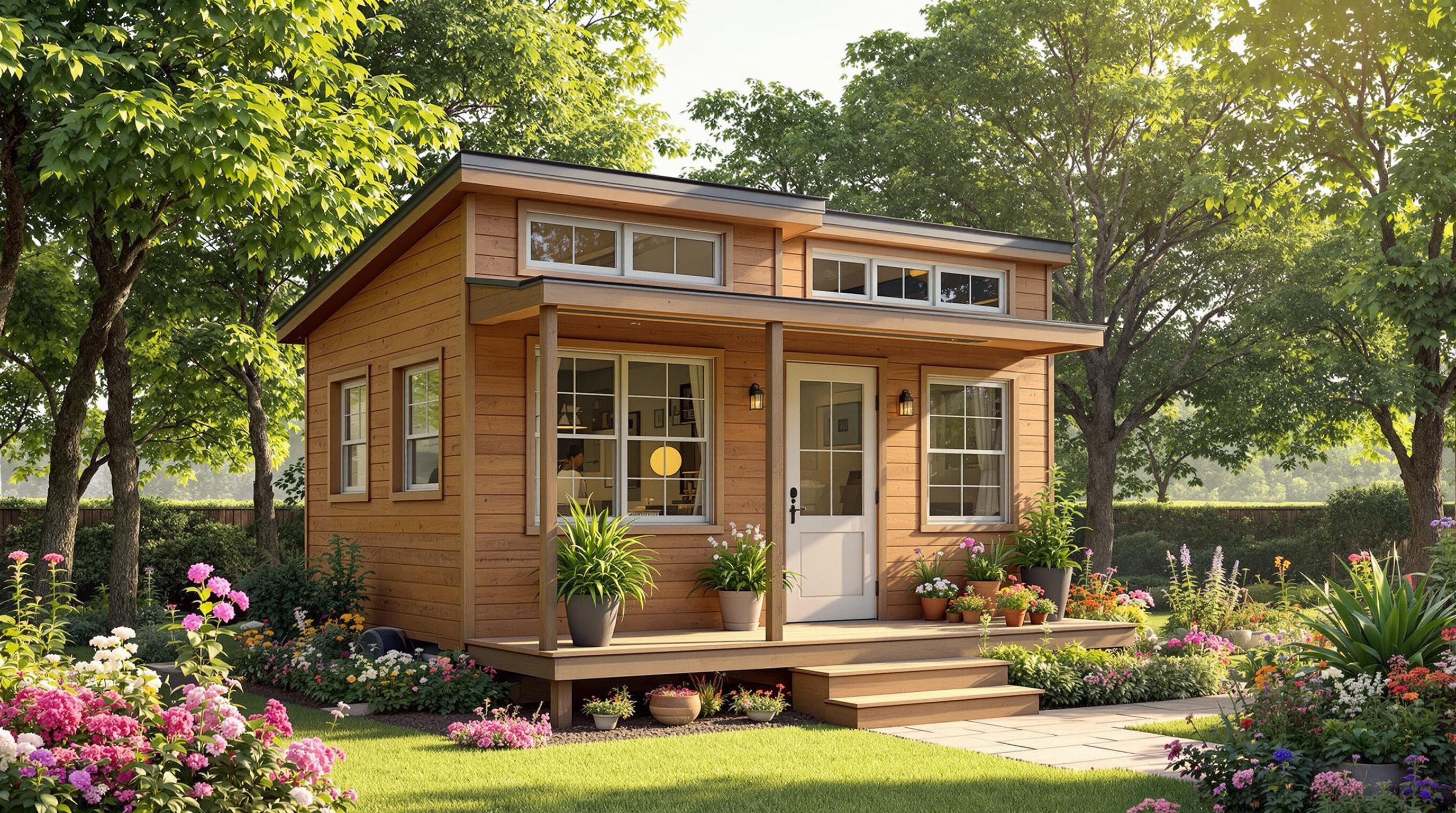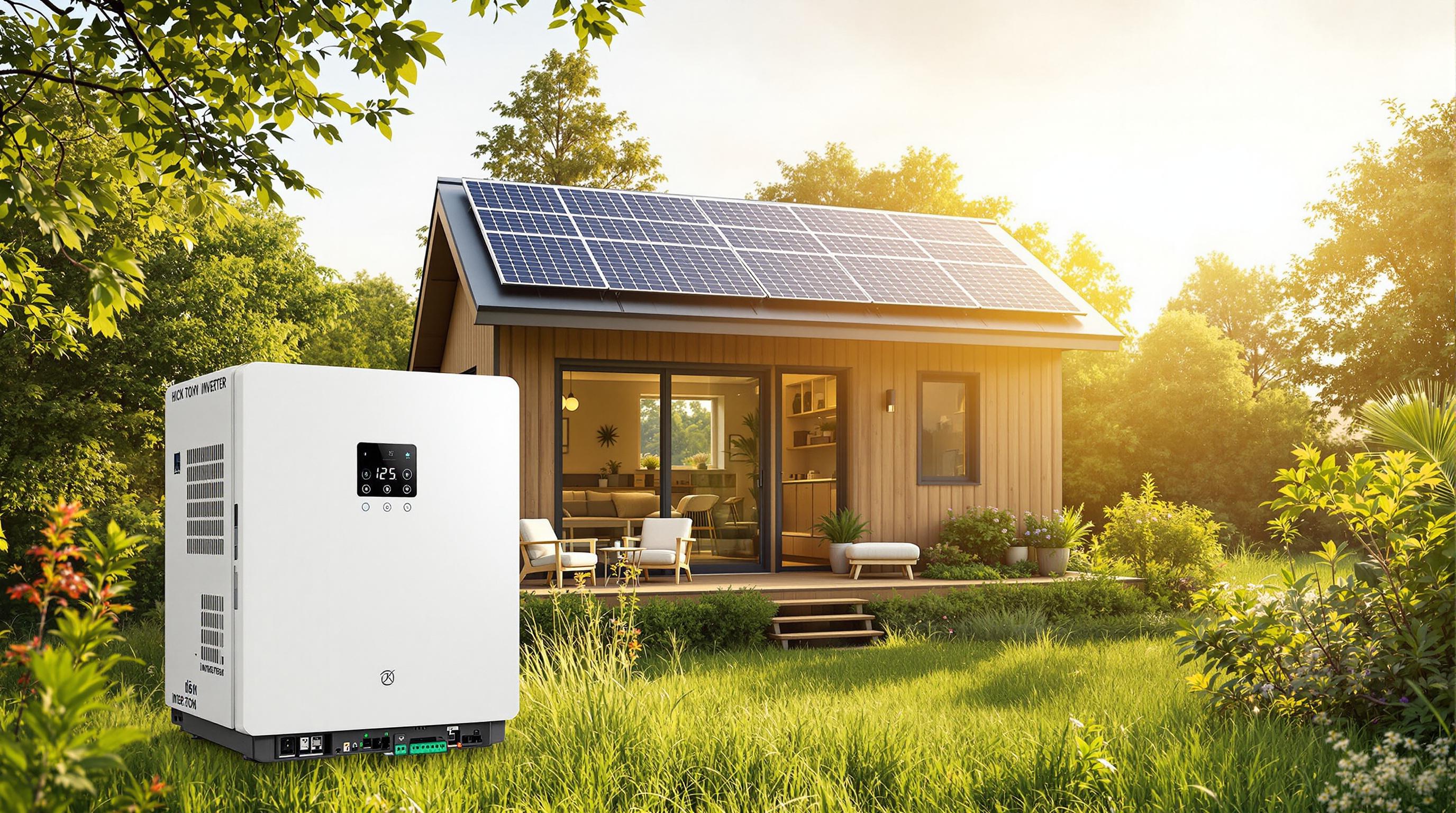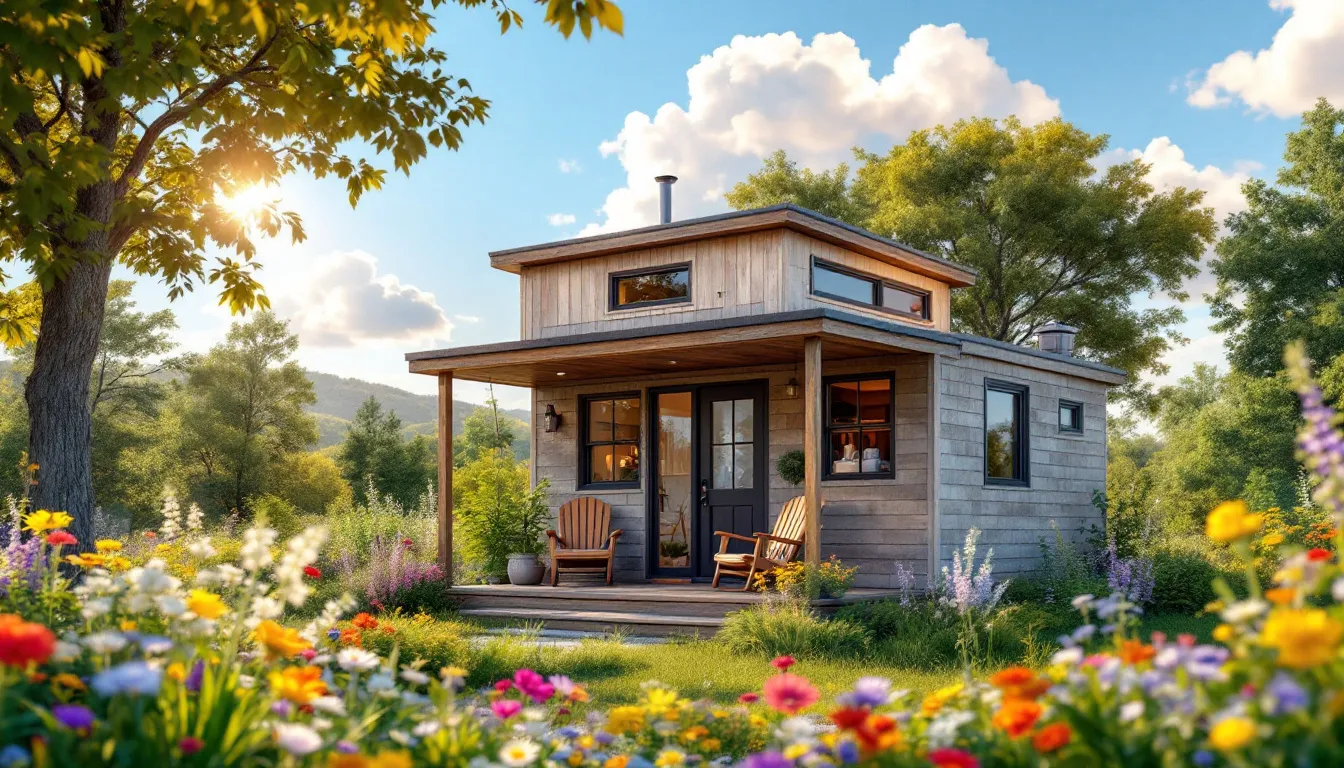Tiny house communities offer lower costs, a smaller environmental impact, and stronger social bonds. But starting one requires navigating zoning laws, finding the right land, and planning utilities and shared spaces.
Key Steps:
- Understand Local Rules: Research zoning laws and building codes. Use tools like Appendix Q to simplify compliance.
- Choose the Right Land: Check for residential zoning, utility access, and minimal environmental impact.
- Plan Utilities: Consider solar panels, composting toilets, and greywater systems for efficiency.
- Design Shared Spaces: Include gardens, community centers, and pathways to encourage interaction.
- Set Rules: Draft a community charter, define responsibilities, and choose a legal structure (e.g., HOA, co-op).
Quick Tip:
Start small and collaborate with local authorities to overcome legal hurdles. Communities like Liberty Village and Tiny Estates show it’s possible with the right planning.
This guide breaks down everything you need to know, from zoning to utilities, to help you create a connected, low-impact tiny house community.
Tiny House Zoning and Legal Issues
Know the Rules: Zoning Laws and Legal Requirements
Before starting a tiny house community, it's essential to understand the zoning laws and building codes in your area. These rules can differ widely from one state, county, or city to another, and they directly affect where and how you can build.
Local Zoning and Building Codes
Dan Fitzpatrick, President of the Tiny Home Industry Association, points out: "Most municipalities require 700 or 1,000 square feet for the minimum size of a house" [3]. This can pose challenges for tiny homes, which are often much smaller.
Here’s a quick breakdown of how tiny homes are classified and the restrictions that may apply:
| Type | Legal Status | Key Restrictions |
|---|---|---|
| Foundation | Permanent Dwelling | Must comply with local codes/zoning |
| Wheels | RV | Often not allowed for permanent use |
| ADU | Secondary Structure | Must follow ADU-specific rules |
Tools Like Appendix Q and Advocacy Groups
Appendix Q, part of the International Residential Code (IRC), has been adopted in states like New York. It provides guidelines for tiny homes, making it easier for them to qualify as Accessory Dwelling Units (ADUs) [6][7]. Success stories, like Tiny Estates in Pennsylvania, show how working with local authorities can simplify the approval process [4][5].
To stay on track:
- Research zoning laws and building codes in your area.
- Work closely with local planning departments.
- Join groups like the Tiny Home Industry Association for support.
- Keep detailed records of utility, foundation, and size requirements.
- Regularly communicate with municipal planning boards to address any concerns.
Choosing the Right Land for Your Community
Check Zoning Rules and Land Use Options
Before buying land, reach out to your local planning department to get details on zoning classifications and utility access requirements. Knowing these regulations upfront can save you from expensive setbacks later on.
Here are some key points to review:
- Residential zoning: Confirm whether multi-unit housing is allowed and check for any minimum size restrictions.
- Utilities: Ensure access to water, sewage, and electricity, and factor in connection costs.
- Building codes: Understand rules about foundations and permanent structures.
Once you have a clear understanding of zoning requirements, it’s time to evaluate the land’s infrastructure and accessibility.
Look at Accessibility and Utility Needs
When considering a site, think about both its current infrastructure and future needs. Make sure utilities are either already available or can be installed affordably.
Key factors to consider include:
- Access to municipal water or the feasibility of a well.
- Sewer connections or septic system options.
- Availability of electrical service.
- Emergency vehicle access to the property.
- Sufficient parking for residents and visitors.
Consider Environmental Impact and Resource Use
Choosing land with minimal environmental impact supports the low-impact living ideals of the tiny house movement. Look for properties that offer:
- Proper drainage to protect ecosystems.
- Space for community gardens or shared green areas.
The land’s topography and natural features will influence both building costs and sustainability. Aim for a location that balances accessibility with conservation efforts.
Collaborate with local authorities to understand environmental regulations and restrictions. Taking this step early can help you avoid unexpected challenges and ensure your community meets both ecological and legal standards.
Thoughtful land selection is the cornerstone of a well-designed, resource-conscious community.
Planning Utilities and Community Layout
Set Up Utilities and Manage Resources
Utilities are a cornerstone of any tiny house community, blending efficiency with practicality. Start with a detailed site assessment to understand resource availability and limitations.
For water, consider combining municipal connections for primary needs with rainwater collection systems for tasks like gardening. A great example comes from Twin Oaks Community in Virginia, where solar panels supply 60% of their energy needs, cutting reliance on the grid and promoting renewable energy.
Here are some independent waste and energy management systems to consider:
- Composting Toilets: Require minimal water and produce garden-friendly fertilizer ($1,200-$3,000 per unit).
- Greywater Systems: Reduce water waste by 40-50% ($4,000-$8,000 per home).
- Solar Power: Offers energy independence and long-term cost savings ($15,000-$25,000 per community).
Once utilities are in place, focus shifts to designing communal spaces that balance functionality with fostering social connections.
Design Shared Spaces for the Community
The Village Homes community in California provides a great example of how shared spaces can bring people together while ensuring privacy. These areas not only encourage interaction but also make the best use of available land.
Key design features to include:
- Central gathering spaces: Build covered pavilions or community centers for year-round use.
- Shared gardens: Dedicate at least 20% of the land to community agriculture.
- Connected pathways: Design walking trails that naturally link private homes to shared spaces.
"The success of a tiny house community largely depends on how well the shared spaces are integrated with private areas. Our experience shows that communities with well-designed common areas see 70% higher resident engagement in community activities", notes the American Tiny House Association's 2023 report.
Covered outdoor areas are especially useful, boosting year-round usability by 40%. Don’t forget to include shared storage spaces for tools and equipment, making them accessible to all residents.
sbb-itb-2ef3f3a
Setting Up Rules and Legal Agreements
Shared spaces and utilities may form the physical core of a tiny house community, but well-defined rules and agreements are what keep everything running smoothly.
Establish Guidelines for Community Living
A community charter is a must-have. This document lays out shared values, responsibilities, and how things operate day-to-day. It’s also your go-to for handling maintenance and resolving conflicts.
Here are some key areas to cover in your guidelines:
- Community behavior: Set expectations for quiet hours, guest policies, and noise levels.
- Shared responsibilities: Define who’s responsible for maintaining private and common areas.
- Animal policies: Include rules about pets, such as cleanup duties and leash requirements.
- Resource use: Outline how shared tools, spaces, and utilities will be managed.
Pick the Right Ownership and Legal Structure
The legal framework of your tiny house community plays a big role in its long-term success. For instance, Cedar Springs Tiny Village in Ohio thrives under a cooperative ownership model, where residents share both ownership and decision-making power [10].
Here’s a quick comparison of common legal models:
| Legal Model | Advantages | Challenges |
|---|---|---|
| Co-op | Shared ownership and decisions | Requires active involvement |
| HOA | Clear governance, property value protection | Higher costs |
| Land Trust | Keeps housing affordable long-term | More complex to set up |
| Land Lease | Lower upfront costs | Limited equity for residents |
To stay compliant, follow these steps:
- Check local zoning and building regulations.
- Organize legal and insurance paperwork.
- Register your community as a legal entity.
Local rules for tiny house communities can vary widely [8][9]. Partnering with advocacy groups in your area can help you navigate these challenges and create a legal framework that supports your community’s growth and stability.
Once you’ve got the rules and legalities sorted, you’re ready to focus on building a connected and efficient community.
Building a Connected and Low-Impact Community
Creating a successful tiny house community means focusing on strong connections and smart resource use. These priorities align with the movement's emphasis on simplicity and mindful living.
Encourage Collaboration and Activities
The Tiny House Village in Oregon sets a great example by hosting monthly workshops where residents share skills like woodworking and sustainable cooking. These gatherings not only teach practical skills but also bring people closer together.
Here are some ways tiny house communities can strengthen bonds:
- Hold monthly town halls to make group decisions.
- Organize workshops to share skills and encourage independence.
- Start community gardens to grow food and build relationships.
- Plan weekly communal dinners to create a sense of belonging.
Promote Resource Efficiency and Waste Reduction
WeeCasa Tiny House Community in Colorado has shown how smart resource management can make a big difference. Their rainwater harvesting system cut water use by 50%, and their waste management program has significantly reduced landfill contributions.
Some effective strategies for managing resources include:
Energy Conservation:
- Use solar panels to power the community.
- Equip shared spaces with energy-saving appliances.
- Install smart lighting systems in common areas.
Waste Management:
- Set up composting and recycling stations to reduce landfill waste, as seen in communities in California.
- Provide clear recycling and reuse guidelines.
Transportation Solutions:
- Create carpooling groups and bike-sharing options.
- Keep parking areas away from homes to encourage walking and make the area more pedestrian-friendly.
To keep improving, communities like the Oregon Tiny House Village conduct yearly environmental audits. These audits help measure their impact and fine-tune their practices, ensuring they stay on track with their goals.
Helpful Tools, Resources, and Examples
Building a tiny house community requires the right resources to make the process smoother and more efficient. Here's a breakdown of tools and platforms that can help you along the way.
Explore Directories Like Tiny Houses For Sale, Rent, and More

Directories such as Tiny Houses For Sale, Rent, and More can connect you with local builders, showcase community designs, and guide you on zoning compliance. These platforms provide insights from existing communities, helping you avoid common mistakes.
Another great resource is the American Tiny House Association (ATHA). They offer zoning updates, legal advice, and networking opportunities, making them an invaluable partner for anyone starting a tiny house community.
Consider DIY Kits and Building Plans
Using standardized building plans or DIY kits can simplify construction and reduce costs. For example, the Tiny House Village in Olympia, Washington, has shown how consistent designs can create a unified community while keeping expenses in check.
| Approach | Benefits | Typical Cost Range | Timeline |
|---|---|---|---|
| Pre-approved Plans | Faster permits, proven designs | $5,000-$15,000 | 2-4 months |
| Custom Designs | Unique features, site-specific | $15,000-$30,000 | 4-6 months |
| DIY Kits | Cost-effective, standardized | $20,000-$45,000 | 3-5 months |
Here are some helpful resources for your planning:
- Tiny House Swoon: Offers IRC-compliant building plans.
- Local Building Departments: Often have pre-approved tiny house designs.
- Experienced Builders: Can adjust standard plans to meet zoning requirements.
For land selection, platforms like LandWatch and Zillow allow you to filter properties based on zoning, utilities, and other essential factors, saving you time and effort.
Conclusion: Steps to Start Your Tiny House Community
Starting a tiny house community takes thoughtful planning and a step-by-step approach. With around 10,000 tiny houses in the U.S. [3], the movement is growing despite the hurdles. Here's how to get started:
Research and Local Regulations
The first step is understanding local rules and restrictions. Look into zoning laws and size requirements to avoid potential roadblocks. Work with local officials and use existing guidelines to meet tiny home standards efficiently.
Key Phases of Development
Building a tiny house community involves several stages. Here's a general timeline to help you plan:
- Research and Legal Work (4-6 months)
Dive into zoning laws, assess community needs, and secure permits. - Site Preparation (6-9 months)
Evaluate the land, plan the layout, and set up utilities and infrastructure.
Laying the Groundwork for Long-Term Success
To ensure your community thrives, focus on these essentials:
- Build strong connections with local governments.
- Partner with advocacy groups for support and guidance.
- Create flexible plans that can adjust to new regulations.
- Keep thorough records of all permits and approvals.
Starting a tiny house community can be challenging, but with the right planning, collaboration, and adaptability, you can create a vibrant and successful living space. Engaging with local leaders and advocacy groups ensures you're set up for both immediate and long-term success.
FAQs
How to build a community of tiny homes?
Creating a thriving tiny house community involves careful planning and attention to a few key areas. Here's what you need to know:
Legal Requirements
Start by researching local rules and regulations. Some states, like California and New York, have loosened zoning restrictions, making it easier to develop tiny home communities [2]. Check if Appendix Q of the Residential Code is relevant in your area [6].
Land Selection
Finding the right land is critical. Look for property that meets zoning requirements, has access to utilities, and allows for shared spaces. Important factors include:
- Zoning that permits tiny homes
- Availability of utilities and infrastructure
- Minimal impact on the surrounding environment
Community Development
Lay the groundwork for a well-functioning community by creating clear guidelines and plans. This includes governance rules, utility management, shared space designs, and resource conservation strategies. Pilot programs can be useful to showcase feasibility and gain local support [1][2]. Well-crafted community covenants and restrictions (CC&Rs) ensure a balance between personal preferences and communal needs [7].



